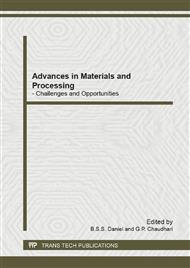p.354
p.359
p.364
p.371
p.376
p.381
p.387
p.392
p.397
Microstructural Studies of Al 5083 Alloy Deformed through Cryorolling
Abstract:
In the present work to investigate the effect of rolling at very low temperature on microstructure of Al 5083 alloy, it was subjected to rolling at room temperature and immediate quenching at liquid nitrogen temperature up to different strain levels. The microstructure of deformed material has been studied using Electron back scattered diffraction (EBSD) and Transmission electron microscopy (TEM) techniques. A homogeneous ultrafine grained microstructure of an average size of 300 nm with well defined grain boundaries could be achieved with an effective rolling strain of only 2.3 followed by short annealing at 300 °C for 6 min. The effect of second phase particles on grain refinement at different stains is discussed. It was observed that increased dislocation density due to effective suppression of dynamic recovery by immediate quenching in liquid nitrogen temperature after each successive rolling passes leads to increased stored energy which further leads to formation of homogeneous ultrafine grained microstructure after short annealing subsequently.
Info:
Periodical:
Pages:
376-380
Citation:
Online since:
November 2012
Authors:
Keywords:
Price:
Сopyright:
© 2012 Trans Tech Publications Ltd. All Rights Reserved
Share:
Citation:


